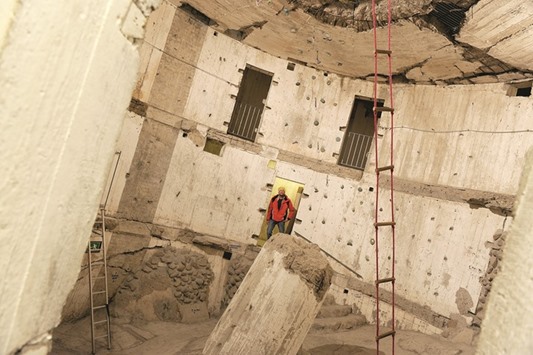The feeling of being queasy hits most visitors on the third step at the latest inside the windowless leaning building.
“OK, I’m staying down here,” quavers one nauseous woman, turning on her heels.
On wobbly legs, the rest of the group continues to climb the concrete steps to the top of the above-ground World War II concrete bunker in Sande, northern Germany.
What makes it so disorientating is that the building is tipped at an angle of 18 degrees, confusing the visitors’ senses. Like a fairground ride, this can be both fun and awful, which is why many of the visitors have sought it out.
“Humans need a perpendicular line and a horizontal line,” explains guide Werner Kleinschmidt. That’s how the eye orientates a person, and the body keeps its balance.
The gaunt German military bunker is much less lovely than the Leaning Tower of Pisa in Italy. But Pisa’s landmark is only 4 degrees off vertical.
Kleinschmidt takes visitors up interior staircases to the windowless fourth floor.
In almost every group there’s at least one “drop-out” as Kleinschmidt calls them.
Around 300 visitors have done the tour since they were first offered in mid 2015, wanting to experience the confusion of the senses it causes.
“But a lot of people notice on the first step already that it’s not their thing,” he says.
At the tower’s centre is a cavernous interior space which is used by the owner, the German Alpine Club, for mountain-climbing training. The mountaineers also climb on the concrete exterior, thanks to its resemblance to the toughest rockfaces in the Alps.
Playing with senses and their perceptions has grown increasingly popular in Germany over the past few years.
Countless places have sprung up where people pay to make themselves dizzy. At “mad houses” in Bispingen, Leipzig and Gettorf, people can visit cottage houses that are literally built upside down.
And in the Phaeno Science Centre, a visitor attraction in the car-making city of Wolfsburg, there are often long queues to get into a “sloping room”, which is visited by around 250,000 people every year.
The Phaeno room is at an angle of 25 degrees from horizontal, scientist Christof Boerner tells visitors.
“The organ we use for balance is in our inner ear. Apart from that, we orientate ourselves very heavily on what we see with our eyes,” says Boerner.
If the senses are in harmony with one another, people can balance.
In the sloping room, the eye attempts to orientate itself by the vertical lines of the wall.
But in a sloping room, they’re at an angle too and people have to incline their heads in order to see the line straight.
But an organ in the inner ear senses the sloping floor and sends signals to the brain to right the body.
“The two perceptions compete with one another,” says Boerner. For some Phaeno visitors it’s too much. But some love testing their senses, especially young people. “For children it’s usually not as bad,” says Boerner.
Unlike the sloping room at Phaeno, the leaning tower of Sande was never meant to be an attraction for thrill-seekers.
British soldiers tried to blow up the German air-defence tower after World War II.
They filled the tower up with water in order to spread the impact wave from the explosives for maximum destruction, but failed to take account of the toilet drainpipes leading out the bottom, which empty into a drain at the nearby railway station at Sande.
“The water leaked out through the toilets,” says Kleinschmidt with a smile.
The 1947 explosion lost its force as a result and instead of collapsing to the ground, the tower keeled over slightly and remained standing. The ruin, which had lost all military value, was later stabilised so it could be brought back into use.
It is so heavily reinforced with steel rods that engineers are convinced the solid ruin will never collapse under its own weight. —DPA

The cavernous interior of the leaning tower of Sande. The rope ladder is hanging vertically. This space is used to train mountain climbers.


